Gianluca Meneghello
 I am an assistant professor in the Geoscience Department at Ecole Normale Superieure - PSL, with a background in Engineering
and Applied Mathematics. My research focuses on the use of
observations and numerical models to improve our understanding of the
dynamics of the ocean and the atmosphere, and on the development of
persistent, autonomous observational platforms.
I am an assistant professor in the Geoscience Department at Ecole Normale Superieure - PSL, with a background in Engineering
and Applied Mathematics. My research focuses on the use of
observations and numerical models to improve our understanding of the
dynamics of the ocean and the atmosphere, and on the development of
persistent, autonomous observational platforms.
Arctic Oceanography

The Arctic Ocean is one of the fastest changing environments on Earth. The dramatic loss of sea ice, driven by temperatures increasing at more than double the global average, is one of the most robust indicators of climate change. At the same time, changes occurring in the Arctic feed back on the global climate. As an example, the Arctic’s ability to accumulate and release freshwater influences the formation of dense water in the North Atlantic and affects the Atlantic meridional overturning circulation.
Because of the presence of sea ice, the Arctic Ocean dynamics differs substantially from what we are used to in other oceans. Common hypothesis behind our understanding of ice-free oceans must be reassessed and tested using observations. My research goes back to the physical oceanography drawing board to understand this important, remote region and the impact of its fast-occurring changes on the global climate.
Hurricane Monitoring

In-situ observations of tropical storms (hurricanes, cyclones, and typhoons) are essential for improving both storms forecast and our understanding of their genesis and development. Despite the continuous development of satellite based products, in-situ observations represent the most important contribution to the initialization of forecast models. They are also difficult, costly, and dangerous to obtain: the design of in-situ observational platforms often requires a tradeoff between persistency --- the ability to observe for long period of time --- and controllability --- the ability to direct observations to particularly interesting areas. My research focuses on a novel approach that uses swarms of atmospheric balloons as a persistent, low-energy, buoyancy controllable platform, with the ability to bridge the gap between persistency and controllability.
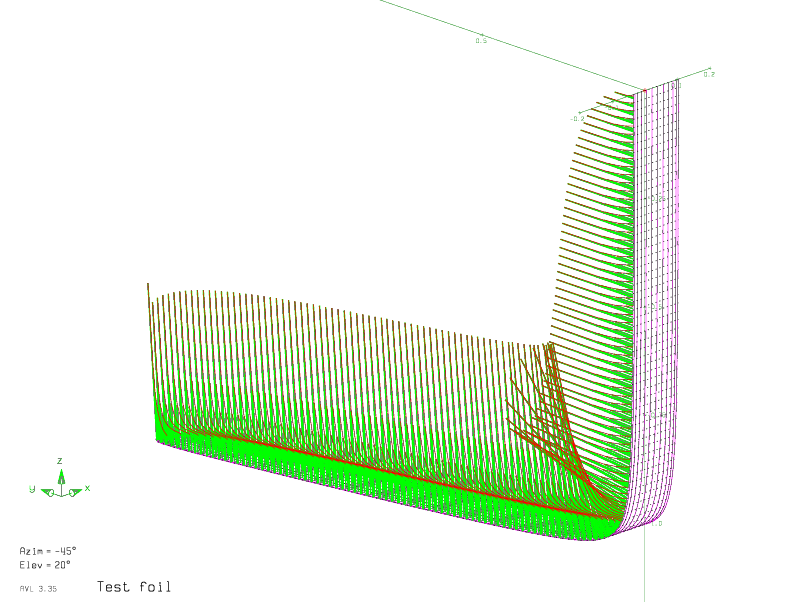 – G. Meneghello, P. Beyhaghi and T. Bewley. Simulation-based optimization of the hydrofoil of a flying catamaran. Unpublished
– G. Meneghello, P. Beyhaghi and T. Bewley. Simulation-based optimization of the hydrofoil of a flying catamaran. UnpublishedA global optimization algorithm recently developed by our group, dubbed ∆- DOGS, is applied to optimize the design of a racing catamaran’s hydrofoil. A computationally inexpensive vortex-lattice based model of the hydrofoil, implemented in AVL (the Athena Vortex Lattice code), is used to compute the flow around the hydrofoil; the suitability of this inexpensive model for such a design optimization is considered carefully in light of available experimental data. While keeping the lift and side force of the hydrofoil constant, the optimization algorithm reduces the drag of the hydrofoil by over a factor of two.
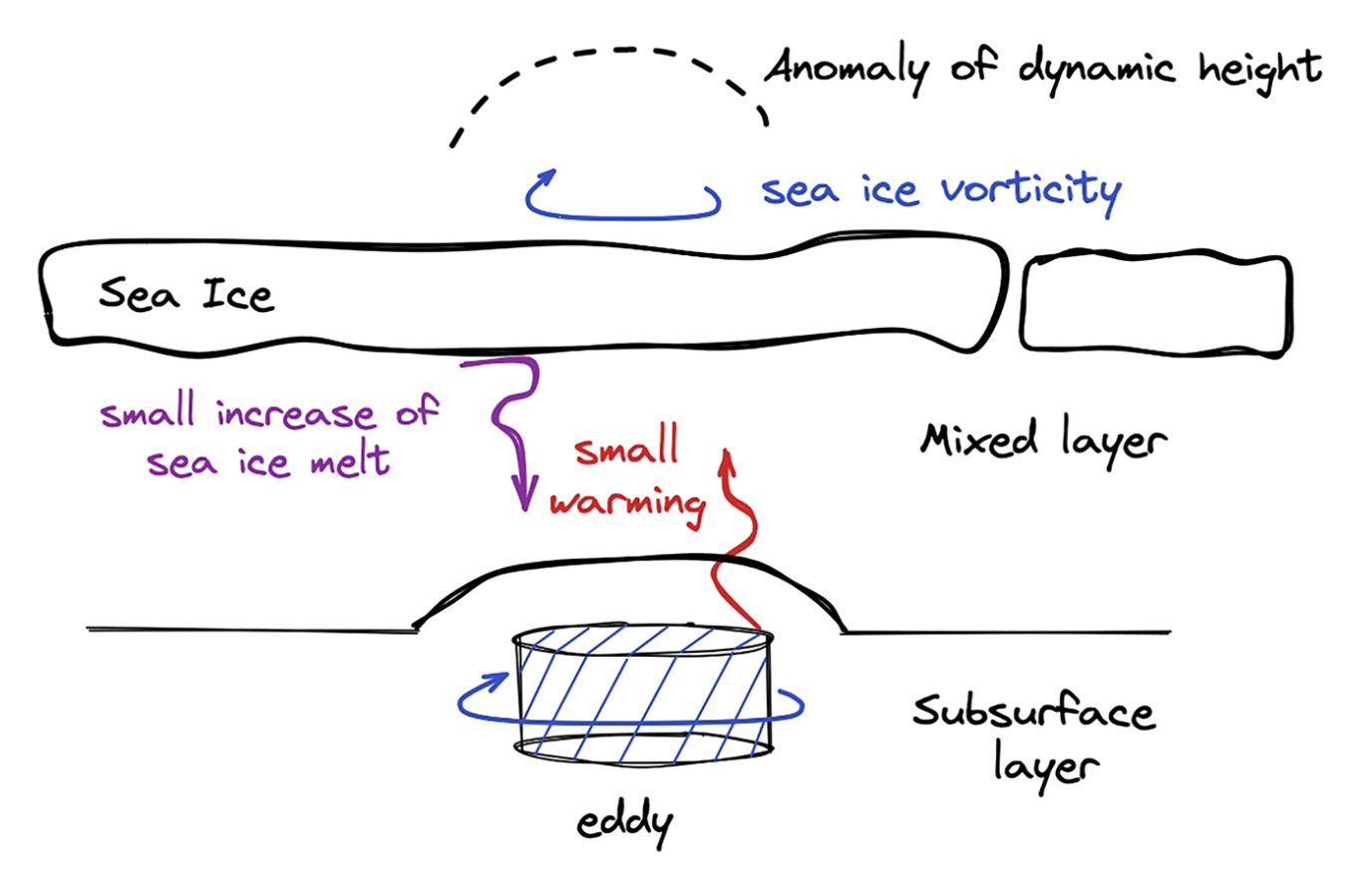 – A. Cassianides, C. Lique, A.-M. Tréguier, G. Meneghello, and C. De Marez.(2023). Observed spatio-temporal variability of the eddy-sea ice interactions in the Arctic Basin. J. Geophys. Res. C: Ocean,
doi:10.1029/2022JC019469
– A. Cassianides, C. Lique, A.-M. Tréguier, G. Meneghello, and C. De Marez.(2023). Observed spatio-temporal variability of the eddy-sea ice interactions in the Arctic Basin. J. Geophys. Res. C: Ocean,
doi:10.1029/2022JC019469
In the Arctic Basin, the ocean dynamics at mesoscale and submesoscale under sea ice are poorly quantified and understood. Here, we analyze comprehensive data sets from Ice Tethered Profilers and moorings from the Beaufort Gyre Observing System spanning the period 2004-2019 in order to characterize the space and time variations of the (sub)mesoscale flow. In seasonally ice-covered regions, the dynamics in the surface layer is largely determined by the presence of sea ice, with an increased eddy kinetic energy and numerous eddies in summer. Beyond these regions, the influence of the sea ice conditions on the first order dynamics is less clear. A wavenumber spectra analysis of observations at the surface and at depth under the sea ice pack reveals that a large variety of regimes can be found, independently of the time and space variations of the sea ice conditions. Focusing on a census of individual eddies, and their potential signature in sea ice, we found that around 500 eddies can be detected in the subsurface layer over 2004-2019, including both submesoscale (radius between 3 and 10 km) and mesoscale (up to 80 km) structures. Based on simple scaling calculations, we quantify the dynamical or thermodynamical signature that these eddies may imprint at the surface. While they do not induce any significant heat flux and subsequent sea ice melt, subsurface eddies can induce a dynamic height anomaly of the order of a few centimetres, resulting into a surface vorticity anomaly strong enough to impact sea ice locally.
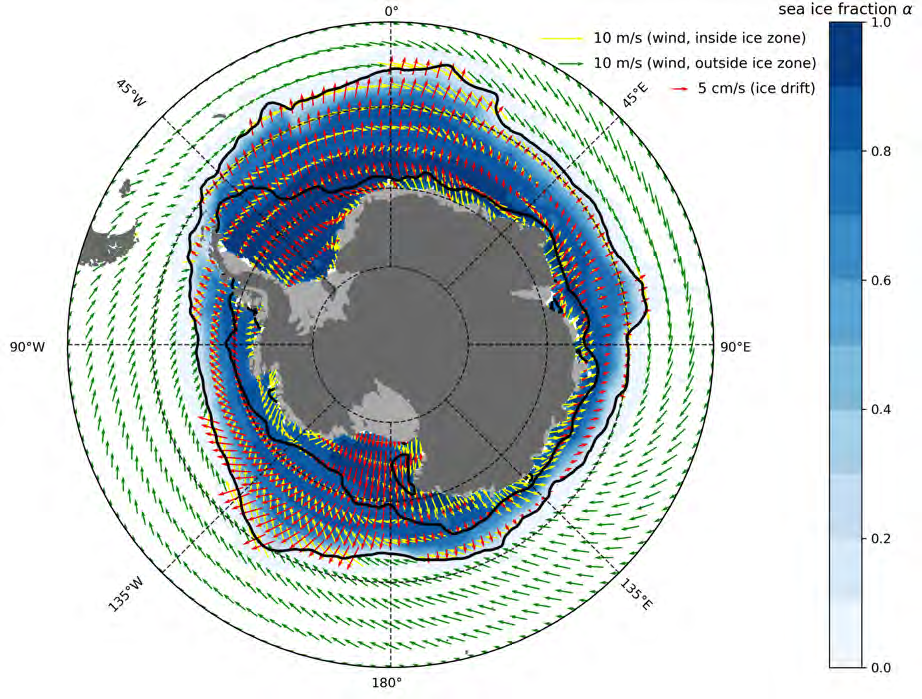 – A.Ramadhan, J.Marshall, G.Meneghello, L.Illari, and K.Speer (2022) Observations of upwelling and downwelling around Antarctica mediated by sea ice.
Front. Mar. Sci. Physical Oceanography,
doi:10.3389/fmars.2022.864808
– A.Ramadhan, J.Marshall, G.Meneghello, L.Illari, and K.Speer (2022) Observations of upwelling and downwelling around Antarctica mediated by sea ice.
Front. Mar. Sci. Physical Oceanography,
doi:10.3389/fmars.2022.864808
We infer circumpolar maps of stress imparted to the ocean by the wind, mediated by sea-ice, in and around the Seasonal Ice Zone (SIZ) of Antarctica. In the open ocean we compute the wind stress using surface winds from daily atmospheric reanalyses and applying bulk formulae. In the presence of sea ice, the stress imparted to the underlying ocean is computed from satellite observations of daily ice concentration and drift velocity assuming, first, that the ocean beneath is not moving, and then including surface geostrophic ocean currents inferred from satellite altimetry. In this way global maps of surface ocean stress in the SIZ are obtained. The maps are discussed and interpreted, and their importance in setting the circulation emphasised. Just as in parallel observational studies in the Arctic, we find that ocean currents significantly modify the stress field, the sense of the surface ageostrophic flow and thus pathways of exchange across the SIZ. Maps of Ekman pumping reveal broad patterns of upwelling within the SIZ which are offset by strong narrow downwelling regions adjacent to the Antarctic continent.
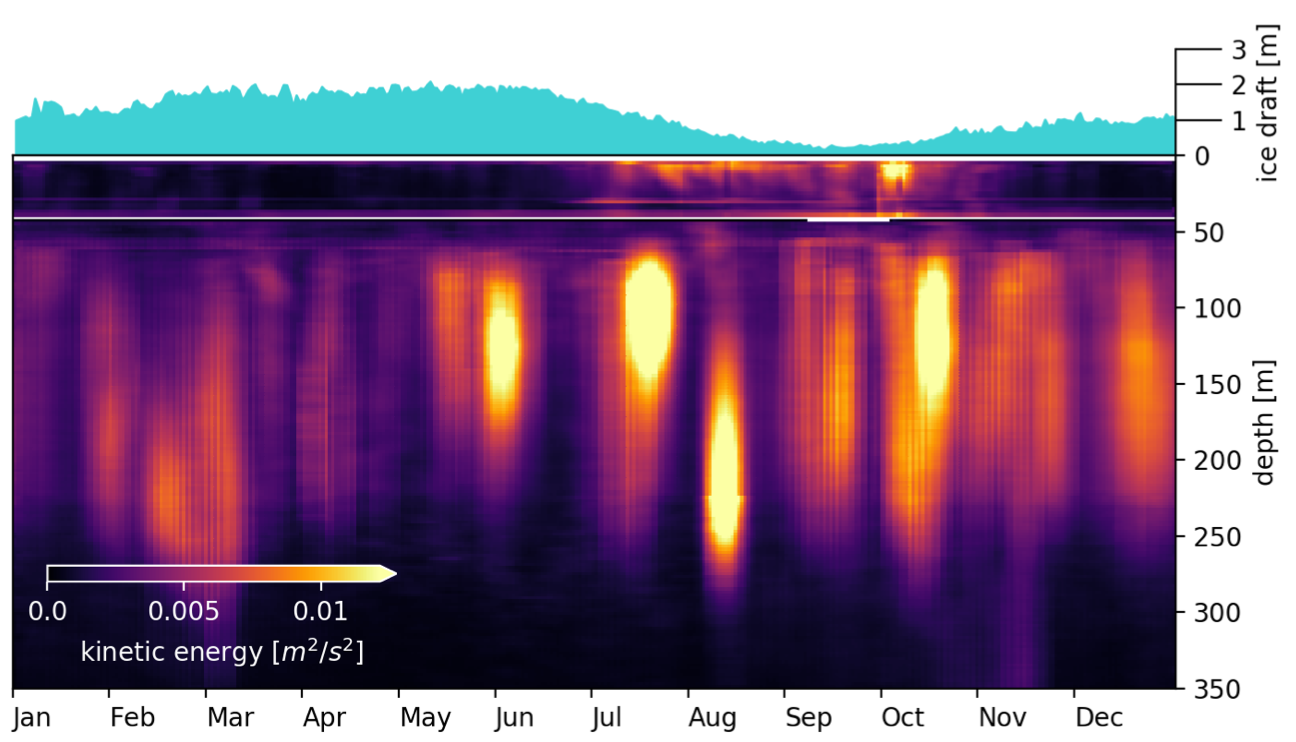 – G. Meneghello, J. Marshall, C. Lique, P.E. Isachsen, E. Doddridge, J-M. Campin, H. Regan, C. Talandier (2021) Genesis and decay of mesoscale baroclinic eddies in the seasonally ice-covered interior Arctic Ocean.
J. Phys. Oceanogr.,
doi:10.1175/JPO-D-20-0054.1
– G. Meneghello, J. Marshall, C. Lique, P.E. Isachsen, E. Doddridge, J-M. Campin, H. Regan, C. Talandier (2021) Genesis and decay of mesoscale baroclinic eddies in the seasonally ice-covered interior Arctic Ocean.
J. Phys. Oceanogr.,
doi:10.1175/JPO-D-20-0054.1
Observations of ocean currents in the Arctic interior show a curious, and hitherto unexplained, vertical and temporal distribution of mesoscale activity. A marked seasonal cycle is found close to the surface: strong eddy activity during summer, observed from both satellites and moorings, is followed by very quiet winters. In contrast, subsurface eddies persist all year long within the deeper halocline and below. Informed by baroclinic instability analysis, we explore the origin and evolution of mesoscale eddies in the seasonally ice-covered interior Arctic Ocean. We find that the surface seasonal cycle is controlled by friction with sea-ice, dissipating existing eddies and preventing the growth of new ones. In contrast, subsurface eddies, enabled by interior potential vorticity gradients and shielded by a strong stratification at a depth of approximately 50 m, can grow independently of the presence of sea ice. A high resolution pan-Arctic ocean model confirms that the interior Arctic basin is baroclinically unstable all year long at depth. We address possible implications for the transport of water masses between the margins and the interior of the Arctic basin, and for climate models’ ability to capture the fundamental difference in mesoscale activity between ice-covered and ice-free regions.
We use ocean observations and reanalyses to investigate the subseasonal predictability of summer and fall sea ice area (SIA) in the western Arctic Ocean associated with lateral ocean heat transport (OHT) through Bering Strait and vertical OHT along the Alaskan coastline from Ekman divergence and upwelling. Results show predictive skill of spring Bering Strait OHT anomalies in the Chukchi Sea and eastern East Siberian Sea for June and July SIA, followed by a sharp drop in predictive skill in August, September, and October and a resurgence of the correlation in November during freeze-up. Fall upwelling of Pacific Water along the Alaskan coastline—a mechanism that was proposed as a preconditioner for lower sea ice concentration (SIC) in the Beaufort Sea the following summer—shows minimal predictive strength on both local and regional scales for any months of the melt season. A statistical hindcast based on May Bering Strait OHT anomalies explains 77% of July Chukchi Sea SIA variance. Using OHT as a predictor of SIA anomalies in the Chukchi Sea improves hindcasts from the simple linear trend by 35% and predictions from spring sea ice thickness anomalies by 24%. This work highlights the importance of ocean heat anomalies for melt season sea ice prediction and provides observational evidence of subseasonal changes in forecast skill observed in model-based forecasts of the Chukchi Sea.
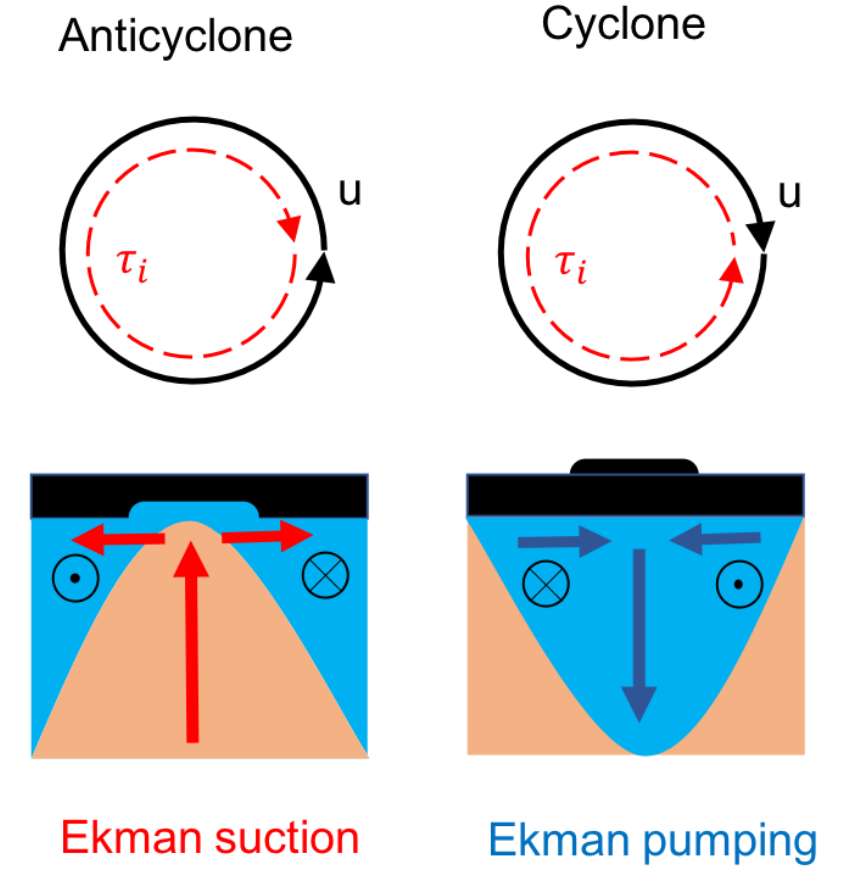 – M. Gupta, J. Marshall, H. Song, J-M Campin, G. Meneghello (2020)
Sea-ice melt driven by ice-ocean stresses on the mesoscale J. Geophys. Res. C: Oceans, doi:10.1029/2020JC016404
– M. Gupta, J. Marshall, H. Song, J-M Campin, G. Meneghello (2020)
Sea-ice melt driven by ice-ocean stresses on the mesoscale J. Geophys. Res. C: Oceans, doi:10.1029/2020JC016404The seasonal ice zone around both the Arctic and the Antarctic coasts is typically characterized by warm and salty waters underlying a cold and fresh layer that insulates sea‐ice floating at the surface from vertical heat fluxes. Here we explore how a mesoscale eddy field rubbing against ice at the surface can, through Ekman‐induced vertical motion, bring warm waters up to the surface and partially melt the ice. We dub this the ‘Eddy Ice Pumping’ mechanism (EIP). When sea‐ice is relatively motionless, underlying mesoscale eddies experience a surface drag that generates Ekman upwelling in anticyclones and downwelling in cyclones. An eddy composite analysis of a Southern Ocean eddying channel model, capturing the interaction of the mesoscale with sea‐ice, shows that within the compact ice zone, the mixed layer depth (MLD) is shallow in anticyclones (∼ 20 m) due to sea‐ice melt and deep in cyclones (∼ 50 ‐ 200 m) due to brine rejection. ‘EIP’ warms the core of anticyclones without significantly affecting the temperature of cyclones, producing a net upward vertical heat flux that reduces the mean sea‐ice thickness by 10 % and shoals the MLD by 60 % over the course of winter and spring. In the following months, the sea‐ice thickness recovers with an overshoot, due to strong negative feedbacks associated with atmospheric cooling and salt stratification. Consequently, the effect of ‘EIP’ does not accumulate over the years, but modulates the seasonal cycle of ice within the compact ice zone.
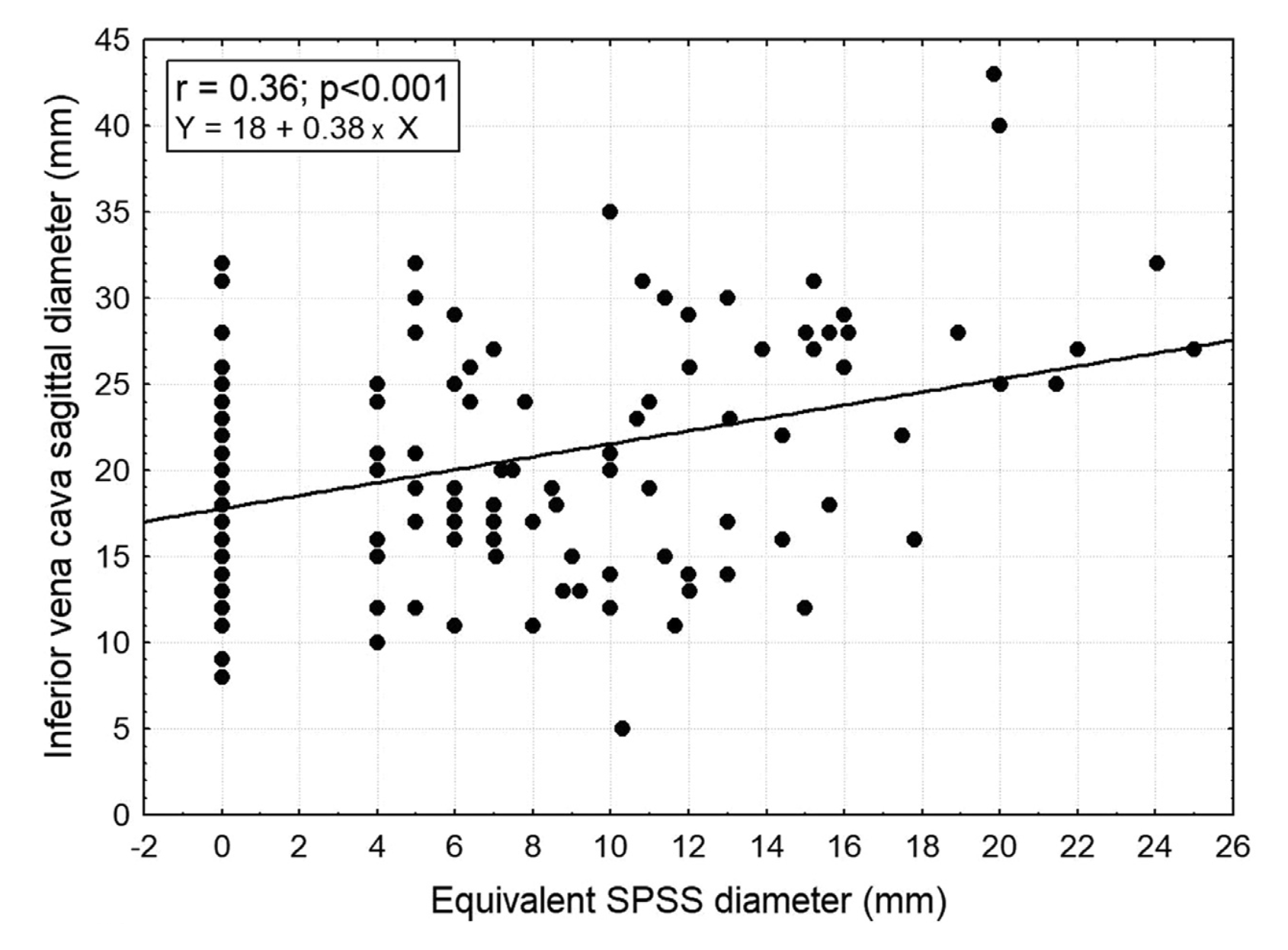 – S. Rathi, S. Brocco, C. Formentin, L. Zarantonello, C. Mangini, G. Meneghello, C. Merkel, P. Angeli, R. Stramare, S. Montagnese, P. Amodio (2020)
Spontaneous portosystemic shunts in cirrhosis: detection, implications, and clinical association.
Digestive and Liver Disease,
doi:10.1016/j.dld.2020.11.020
– S. Rathi, S. Brocco, C. Formentin, L. Zarantonello, C. Mangini, G. Meneghello, C. Merkel, P. Angeli, R. Stramare, S. Montagnese, P. Amodio (2020)
Spontaneous portosystemic shunts in cirrhosis: detection, implications, and clinical association.
Digestive and Liver Disease,
doi:10.1016/j.dld.2020.11.020
Background: Spontaneous portosystemic shunts (SPSS) are common in cirrhosis. Their characterization and clinical implications remain unclear.
Aims: To devise a system of assessment of these shunts, and assess their clinical implications.
Methods: We retrospectively studied patients with cirrhosis who underwent imaging in a liver transplant program. A novel index was computed to assess total SPSS -the diameter of a circle having an area equivalent to the sum of the areas of all the existing shunts. This ‘SPSS equivalent diameter’ was compared with the clinical variables.
Results: Among 127 patients, 70% (CI95% 62–77) had SPSS, and 57% (CI95% 62–77) had multiple SPSS. The risk for SPSS was related to the severity of cirrhosis (Child-Pugh B/C vs. A: OR 2.4 CI95% 1.1–5.4) and alcoholic aetiology (OR 2.9 CI95% 1.2–7.1). The SPSS equivalent diameter was related to a history of HE, cognitive impairment (EEG/PHES) and ammonia(p<0.05). The diameter of the inferior cava vein >19.5 mm was a predictor of large SPSS (AUC 0.77, CI95%:0.68–0.87, p ≤ 0.001).
Conclusions: The SPSS equivalent diameter, a comprehensive assessment of portosystemic shunting, was associated with severity of liver disease, hyperammonemia, and cognitive dysfunction. The diameter of the inferior vena cava was a good predictor of SPSS.
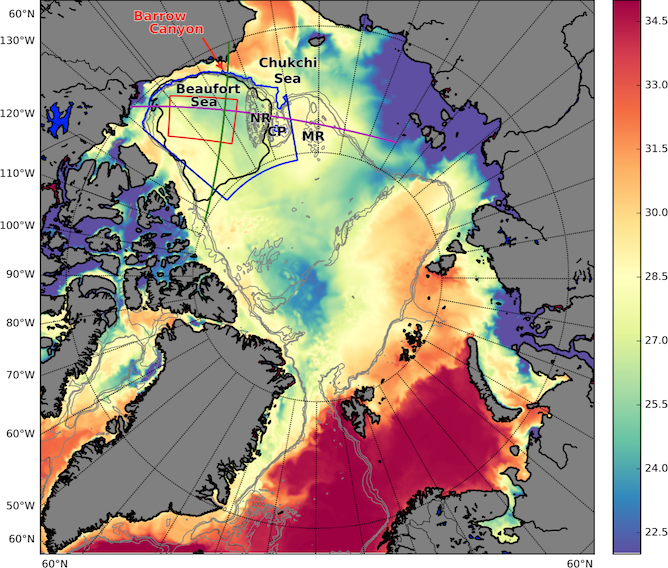 – H. Regan, C. Lique, C. Talandier, G. Meneghello (2020) Response of Total and Eddy Kinetic Energy to the recent spin up of the Beaufort Gyre.
J. Phys. Oceanogr., 50(3), doi:10.1175/JPO-D-19-0234.1
– H. Regan, C. Lique, C. Talandier, G. Meneghello (2020) Response of Total and Eddy Kinetic Energy to the recent spin up of the Beaufort Gyre.
J. Phys. Oceanogr., 50(3), doi:10.1175/JPO-D-19-0234.1The Beaufort Gyre in the Arctic Ocean has spun up over the past two decades in response to changes of the wind forcing and sea ice conditions, accumulating a significant amount of freshwater. Here a simulation performed with a high-resolution, eddy resolving model is analyzed in order to provide a detailed description of the total and eddy kinetic energy, and their response to this spin up of the gyre. On average, and in contrast to the typical open ocean conditions, the levels of mean and eddy kinetic energy are of the same order of magnitude, and the eddy kinetic energy is only intensified along the boundary and in the subsurface. In response to the strong anomalous atmospheric conditions in 2007, the gyre spins up and the mean kinetic energy almost doubles, while the eddy kinetic energy does not increase significantly for a long time period. This is because the isopycnals are able to flatten and the gyre expands outwards, reducing the potential for baroclinic instability. These results have implications for understanding the mechanisms at play for equilibrating the Beaufort Gyre and the variability and future changes of the Arctic freshwater system.
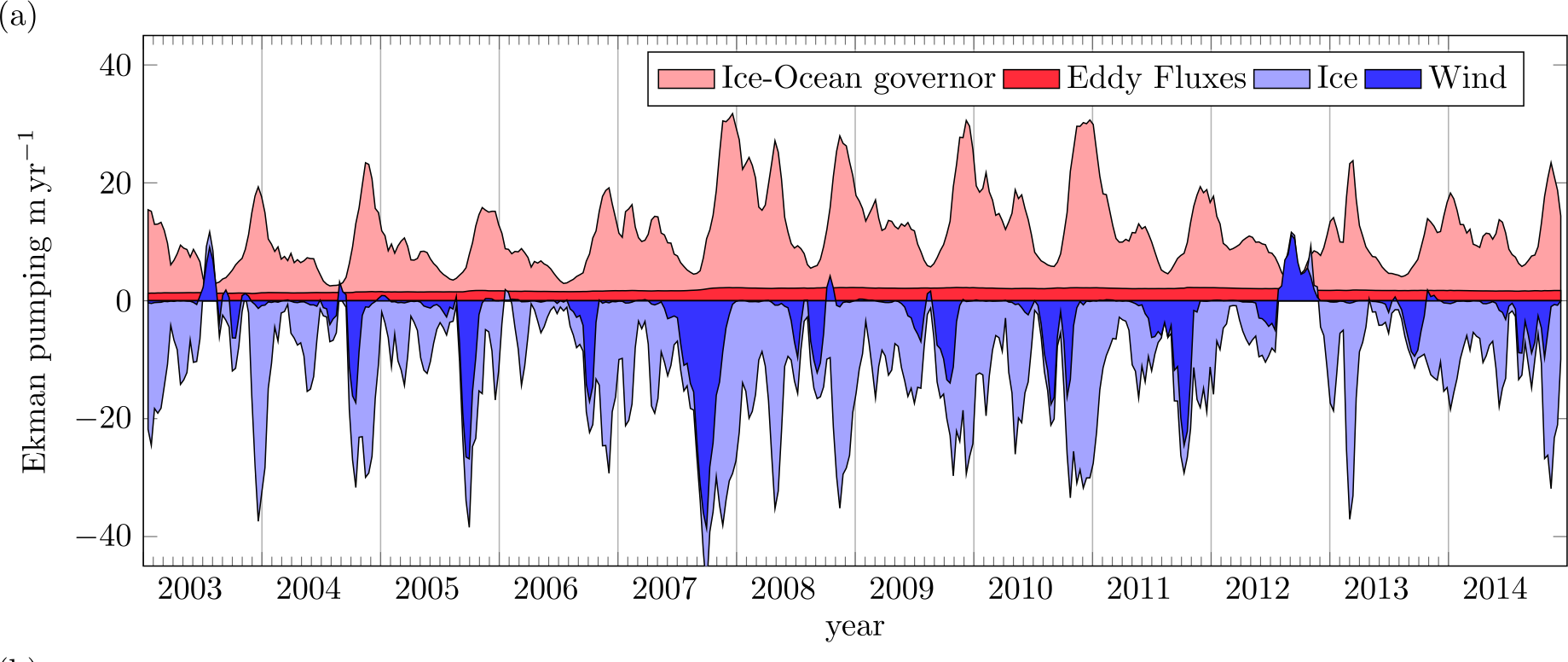 – G. Meneghello, E. W. Doddridge, J. Marshall, J. Scott, J-M Campin (2020) Exploring the role of the “Ice-Ocean governor” and mesoscale eddies in the equilibration of the Beaufort Gyre: lessons from observations.
J. Phys. Oceanogr., 50(1), doi:10.1175/JPO-D-18-0223.1
– G. Meneghello, E. W. Doddridge, J. Marshall, J. Scott, J-M Campin (2020) Exploring the role of the “Ice-Ocean governor” and mesoscale eddies in the equilibration of the Beaufort Gyre: lessons from observations.
J. Phys. Oceanogr., 50(1), doi:10.1175/JPO-D-18-0223.1Observations of Ekman pumping, sea surface height anomaly, and isohaline depth anomaly over the Beaufort Gyre are used to explore the relative importance and role of (i) feedbacks between ice and ocean currents, dubbed the “Ice-Ocean governor” and (ii) mesoscale eddy processes in the equilibration of the Beaufort Gyre. A two-layer model of the gyre is fit to observations and used to explore the mechanisms governing the gyre evolution from the monthly to the decennial time scale. The Ice-Ocean governor dominates the response on inter-annual timescales, with eddy processes becoming evident on the longest, decadal timescales.
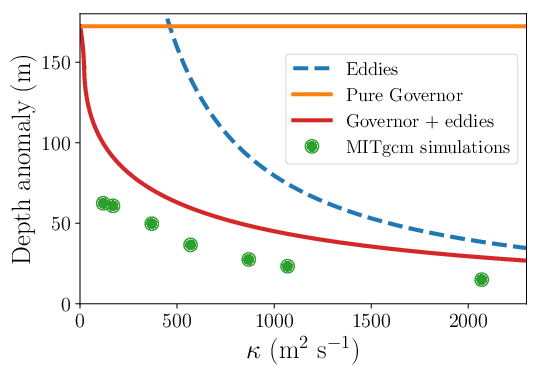 – E. W. Doddridge, G. Meneghello, J. Marshall, J. Scott, C. Lique (2019)
A Three-way Balance in The Beaufort Gyre: The Ice-Ocean Governor, Wind Stress, and Eddy Diffusivity.
J. Geophys. Res. C: Oceans, 124(5), 3107-3124, doi:10.1029/2018JC014897
– E. W. Doddridge, G. Meneghello, J. Marshall, J. Scott, C. Lique (2019)
A Three-way Balance in The Beaufort Gyre: The Ice-Ocean Governor, Wind Stress, and Eddy Diffusivity.
J. Geophys. Res. C: Oceans, 124(5), 3107-3124, doi:10.1029/2018JC014897The Beaufort Gyre (BG) is a large anticyclonic circulation in the Arctic Ocean. Its strength is directly related to the halocline depth, and therefore also to the storage of freshwater. It has recently been proposed that the equilibrium state of the BG is set by the Ice-Ocean Governor, a negative feedback between surface currents and ice-ocean stress, rather than a balance between lateral mesoscale eddy fluxes and surface Ekman pumping. However, mesoscale eddies are present in the Arctic Ocean; it is therefore important to extend the Ice-Ocean Governor theory to include lateral fluxes due to mesoscale eddies. Here, a non-linear ordinary differential equation is derived that represents the effects of wind-stress, the Ice-Ocean Governor, and eddy fluxes. Equilibrium and time-varying solutions to this three-way balance equation are obtained and shown to closely match the output from a hierarchy of numerical simulations, indicating that the analytical model represents the processes controlling BG equilibration. The equilibration timescale derived from this three-way balance is faster than the eddy equilibration timescale and slower than the Ice-Ocean Governor equilibration timescales for most values of eddy diffusivity. The sensitivity of the BG equilibrium depth to changes in eddy diffusivity and the presence of the Ice-Ocean Governor is also explored. These results show that predicting the response of the BG to changing surface forcing and sea ice conditions requires faithfully capturing the three-way balance between the Ice-Ocean Governor, wind stress, and eddy fluxes.
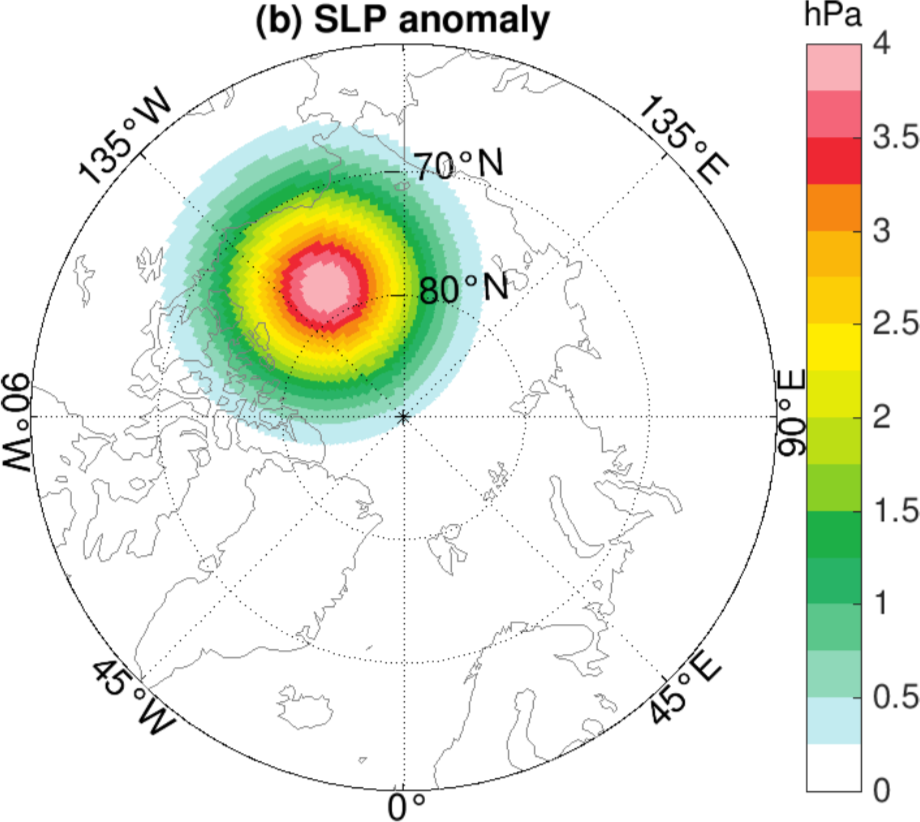 – Q. Wang, J. Marshall, J. Scott, G. Meneghello, S. Danilov, T. Jung (2018) On the feedback of ice-ocean stress coupling from geostrophic currents in an anticyclonic wind regime over the Beaufort Gyre. J. Phys. Oceanogr., 49(2), 369-383, doi:10.1175/JPO-D-18-0185.1
– Q. Wang, J. Marshall, J. Scott, G. Meneghello, S. Danilov, T. Jung (2018) On the feedback of ice-ocean stress coupling from geostrophic currents in an anticyclonic wind regime over the Beaufort Gyre. J. Phys. Oceanogr., 49(2), 369-383, doi:10.1175/JPO-D-18-0185.1Based on analysis of observational data it has been suggested that a negative feedback of ice-ocean stress coupling may limit freshwater accumulation in the Beaufort Gyre (BG). In this paper we explore how this feedback can significantly contribute to BG stabilization in an anticyclonic wind regime. We use an ice-ocean model and turn on and off the feedback in simulations to elucidate the role of the feedback. When a persistent anticyclonic wind anomaly is applied over the BG, liquid freshwater content (FWC) increases due to enhanced Ekman downwelling. As a consequence, ocean surface geostrophic currents speed up. However, the spin-up of sea ice is weaker than the acceleration of surface geostrophic currents during wintertime, due to strong sea ice internal stress when ice concentration is high and ice is thick. This leads to cyclonic anomalies in the ice-ocean relative velocity and stress over the BG. The resultant seasonal Ekman upwelling anomaly reduces freshwater accumulation by about 1/4 as compared to a simulation with the negative feedback turned off in a control experiment, with a reduction range of 1/10 to 1/3 in all experiments conducted. We show that the feedback is more effective when the model’s mesoscale eddy diffusivity is smaller or when sea ice internal stress is stronger. Finally, we argue that the ice-ocean stress feedback may become less significant as the Arctic warms and sea ice declines.
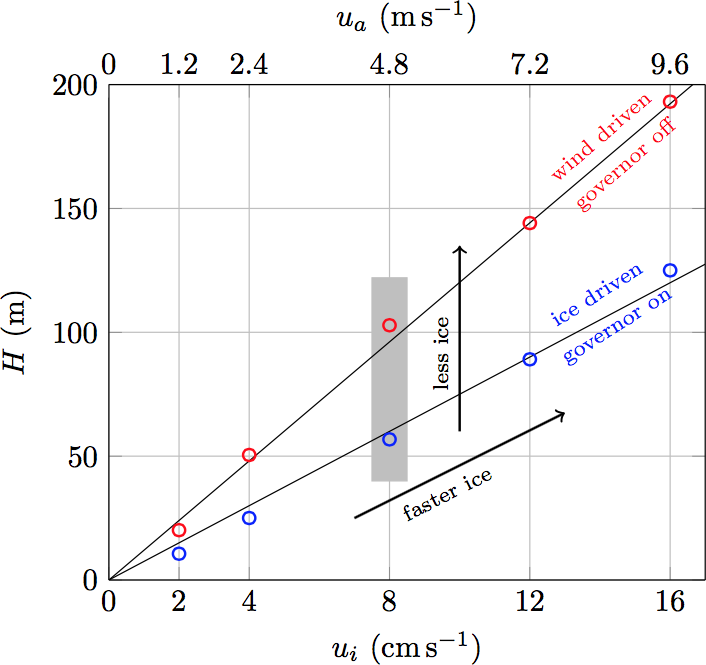 – G. Meneghello, J. Marshall, J.-M. Campin, E. W. Doddridge, M.-L. Timmermans (2018) The Ice-Ocean governor: ice-ocean stress feedback limits Beaufort Gyre spin up. Geophys. Res. Lett., 45. doi:10.1029/2018GL080171
– G. Meneghello, J. Marshall, J.-M. Campin, E. W. Doddridge, M.-L. Timmermans (2018) The Ice-Ocean governor: ice-ocean stress feedback limits Beaufort Gyre spin up. Geophys. Res. Lett., 45. doi:10.1029/2018GL080171Featured in: MIT Spotlight, MIT News, AGU GeoSpace, phys.org, ScienceDaily, AAAS, Digital Journal
The Beaufort Gyre is a key circulation system of the Arctic Ocean and its main reservoir of freshwater. Freshwater storage and release affects Arctic sea-ice cover, as well as North Atlantic and global climate. We describe a mechanism that is fundamental to the dynamics of the Gyre, namely the "ice-ocean stress governor". Wind blows over the ice and the ice drags the ocean. But as the gyre spins up, currents catch the ice up and turn off the surface stress. This governor sets the basic properties of the gyre, such as its depth, freshwater content, and strength. Analytical and numerical modeling is employed to contrast the equilibration processes in an ice-covered versus ice-free gyre. We argue that as the Arctic warms, reduced sea-ice extent and more mobile ice will result in a deeper and faster Beaufort Gyre, accumulating more freshwater that will be released by Ekman upwelling or baroclinic instability.
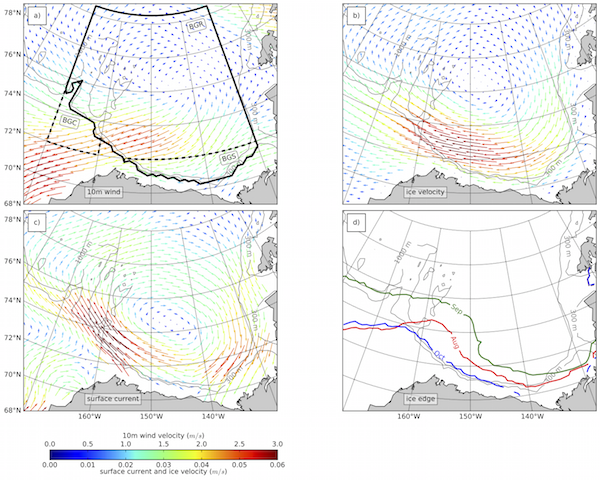 – G. Meneghello, J. Marshall, M.-L. Timmermans and J. Scott (2018) Observations of seasonal upwelling and downwelling in the Beaufort Sea mediated by sea ice. J. Phys. Oceanogr., 48(4), 795–805. doi:10.1175/JPO-D-17-0188.1; dataset doi:10.18739/A2J678X08
– G. Meneghello, J. Marshall, M.-L. Timmermans and J. Scott (2018) Observations of seasonal upwelling and downwelling in the Beaufort Sea mediated by sea ice. J. Phys. Oceanogr., 48(4), 795–805. doi:10.1175/JPO-D-17-0188.1; dataset doi:10.18739/A2J678X08We present observational estimates of Ekman pumping in the Beaufort Gyre region. Averaged over the Canada Basin, our results show a 2003-2012 average of 2.5m/y downward with strong seasonal and interannual variability superimposed: monthly and yearly means range from 30m/y downward to 10m/y upward. A clear seasonal cycle is evident with intense downwelling in autumn and upwelling during the winter months. Wintertime upwelling is associated with friction between the large scale Beaufort Gyre ocean circulation and the surface ice pack, and contrasts with previous estimates of year-long downwelling; as a consequence, the yearly cumulative Ekman pumping over the gyre is significantly reduced. The spatial distribution of Ekman pumping is modified as well, with the Beaufort Gyre region showing alternating, moderate upwelling and downwelling, while a more intense, year-long downwelling averaging 17.5m/y is identified in the northern Chukchi Sea region. Implications of our results for understanding Arctic Ocean dynamics and change are discussed.
 – G. Meneghello, J. Marshall, S.T. Cole, and M.-L. Timmermans (2017) Observational inferences of lateral eddy diffusivity in the halocline of the Beaufort Gyre. Geophys. Res. Lett., 44. doi:10.1002/2017GL075126
– G. Meneghello, J. Marshall, S.T. Cole, and M.-L. Timmermans (2017) Observational inferences of lateral eddy diffusivity in the halocline of the Beaufort Gyre. Geophys. Res. Lett., 44. doi:10.1002/2017GL075126Using Ekman pumping rates mediated by sea-ice in the Arctic Ocean's Beaufort Gyre (BG), the magnitude of lateral eddy diffusivities required to balance downward pumping is inferred. In this limit --- that of vanishing residual-mean circulation --- eddy-induced upwelling exactly balances downward pumping. The implied eddy diffusivity varies spatially with values of 50-400 m2/s, and decays with depth. Eddy diffusivity estimated using mixing length theory applied to BG mooring data exhibits a similar range of values from 100 m2/s to more than 600 m2/s, and also decays with depth. We conclude that eddy diffusivities in the BG are likely large enough to balance downward Ekman pumping, arresting the deepening of the gyre and suggesting that eddies play a zero-order role in buoyancy and freshwater budgets of the BG.
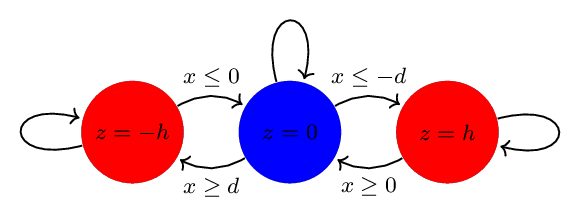 – G. Meneghello, P. Luchini and T. Bewley (2017) A probabilistic framework for the
control of systems with discrete states and stochastic excitation. Automatica. doi:10.1016/j.automatica.2017.11.001
– G. Meneghello, P. Luchini and T. Bewley (2017) A probabilistic framework for the
control of systems with discrete states and stochastic excitation. Automatica. doi:10.1016/j.automatica.2017.11.001A probabilistic framework is proposed for the optimization of efficient switched control strategies for physical systems dominated by stochastic excitation. In this framework, the equation for the state trajectory is replaced with an equivalent equation for its probability distribution function in the constrained optimization setting. This allows for a large class of control rules to be considered, including hysteresis and a mix of continuous and discrete random variables. The problem of steering atmospheric balloons within a stratified flowfield is a motivating application; the same approach can be extended to a variety of mixed-variable stochastic systems and to new classes of control rules.
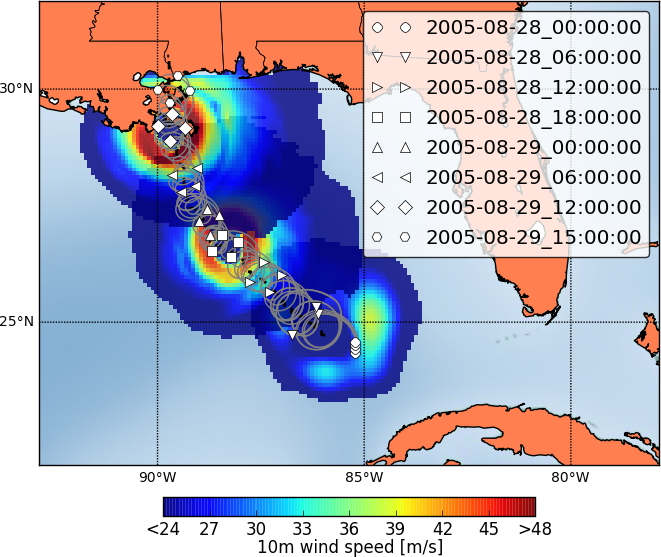 – T. Bewley and G. Meneghello (2016) Efficient coordination of swarms of sensor-laden balloons for persistent, in situ, real-time measurement of hurricane development. Physical Review Fluids 1.6, 060507. doi: 10.1103/PhysRevFluids.1.060507
– T. Bewley and G. Meneghello (2016) Efficient coordination of swarms of sensor-laden balloons for persistent, in situ, real-time measurement of hurricane development. Physical Review Fluids 1.6, 060507. doi: 10.1103/PhysRevFluids.1.060507Featured in: UCSD news, ECNMag, ScienceDaily and DigitalTrends
Accurate long-term forecasts of the path and intensity of severe hurricanes are imperative to protect property and save lives. Extensive real-time measurements within hurricanes, especially near their core, are essential for supplementing the limited relevant information accessible by satellites in order to improve such forecasts. Current operational methods for obtaining in situ information, such as dropsondes and repeated manned and unmanned aircraft flights over and within hurricanes, are both expensive and limited in duration. In the present work it is demonstrated by numerical experiments how a swarm of robust, inexpensive, buoyancy-controlled, sensor-laden balloons might be deployed and controlled in an energetically efficient, coordinated fashion, for days at a time, to continuously monitor relevant properties (pressure, humidity, temperature, and wind speed) of a hurricane as it develops. Rather than fighting its gale-force winds, the strong and predictable stratification of these winds is leveraged to efficiently disperse the balloons into a favorable time- evolving distribution. An iterative bootstrap approach is envisioned in which (a) sensor balloons are used to help improve the available computational estimate of the uncertain and underresolved flow field of the hurricane and (b) this (imprecise) estimate of the hurricane flow field is leveraged to improve the distribution of the sensor balloons, which then better facilitates (a), etc. The control approach envisioned in this ambitious effort is a combination of (centrally computed) model predictive control for coordination at the largest scales, which is the focus of the present paper, coupled with a feedback control strategy (decentrally computed, on the balloons themselves), for smaller-scale corrections. Our work indicates that, following such an approach, certain target orbits of interest within the hurricane can be continuously sampled by some balloons, while others make repeated sweeps between the eye and the spiral rain bands.
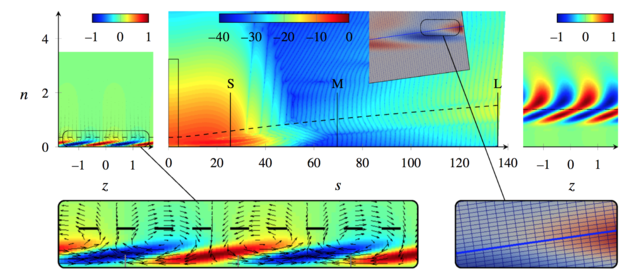 – G. Meneghello, P.J. Schmid, and P. Huerre (2015) Receptivity and sensitivity of the leading-edge boundary layer of a swept wing. Journal of Fluid Mechanics 775, R1. doi: 10.1017/jfm.2015.282
– G. Meneghello, P.J. Schmid, and P. Huerre (2015) Receptivity and sensitivity of the leading-edge boundary layer of a swept wing. Journal of Fluid Mechanics 775, R1. doi: 10.1017/jfm.2015.282A global stability analysis of the boundary layer in the leading edge of a swept wing is performed in the incompressible flow regime. It is demonstrated that the global eigenfunctions display the features characterizing the local instability of the attachment line, as in swept Hiemenz flow, and those of local cross-flow instabilities further downstream along the wing. A continuous connection along the chordwise direction is established between the two local eigenfunctions. An adjoint-based receptivity analysis reveals that the global eigenfunction is most responsive to forcing applied in the immediate vicinity of the attachment line. Furthermore, a sensitivity analysis identifies the wavemaker at a location that is also very close to the attachment line where the corresponding local instability analysis holds: the local cross-flow instability further along the wing is merely fed by its attachment-line counterpart. As a consequence, global mode calculations for the entire leading-edge region only need to include attachment-line structures. The result additionally implies that effective open-loop control strategies should focus on base-flow modifications in the region where the local attachment-line instability prevails.
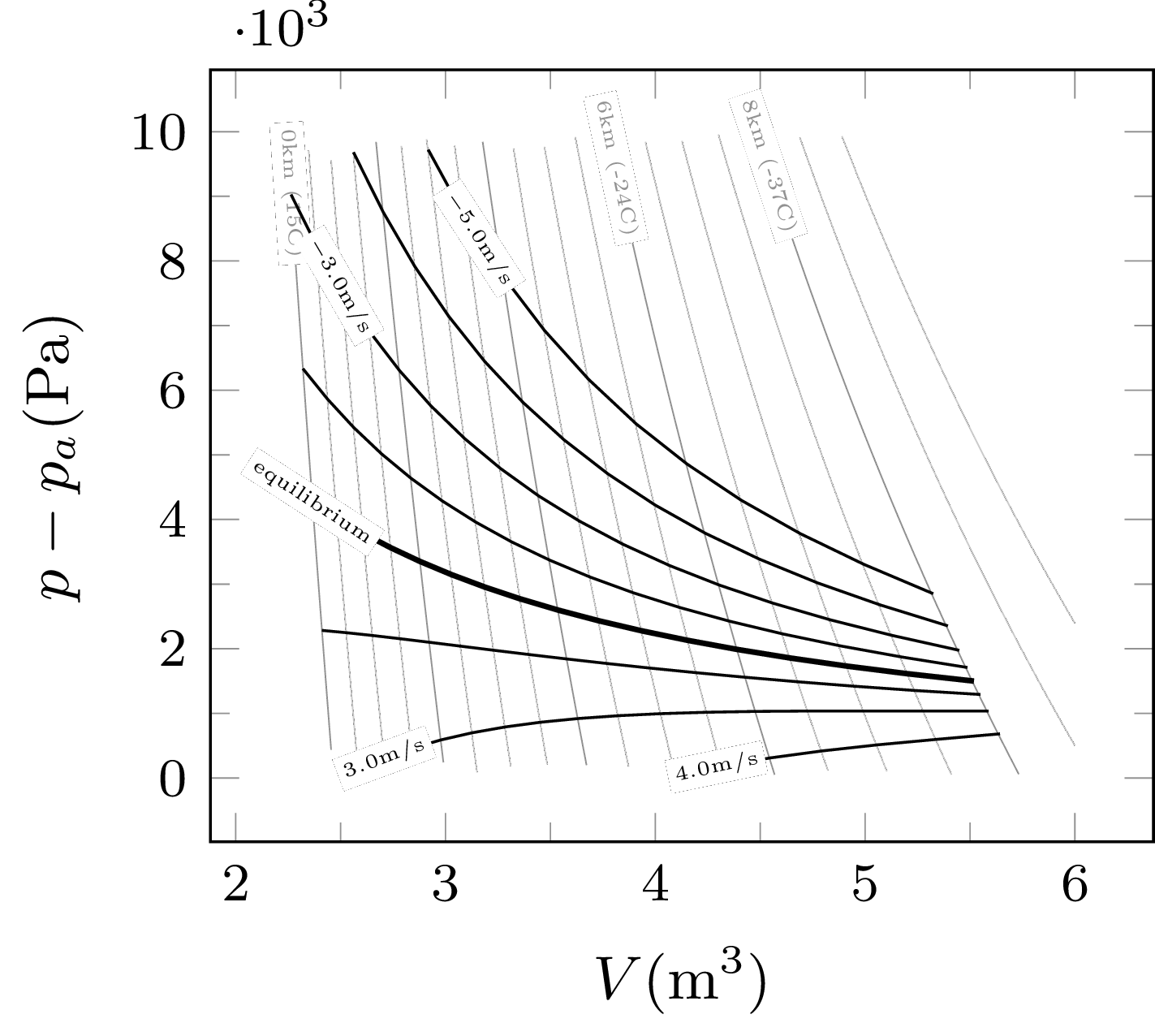 – G. Meneghello, T. Bewley, M. de Jong and C. Briggs (2017) A coordinated balloon observation system for sustained in-situ measurements of hurricanes. 2017 IEEE Aerospace Conference, Big Sky, Montana. doi: 10.1109/AERO.2017.7943798
– G. Meneghello, T. Bewley, M. de Jong and C. Briggs (2017) A coordinated balloon observation system for sustained in-situ measurements of hurricanes. 2017 IEEE Aerospace Conference, Big Sky, Montana. doi: 10.1109/AERO.2017.7943798In this paper, a low-cost balloon observation system is proposed for sustained (week-long), broadly distributed, in-situ measurements of hurricane development. The high-quality, high-density (in both space and time) measurements to be made available by such a system should be instrumental in significantly improving our ability to forecast such extreme and dangerous atmospheric events. The present paper focuses specifically on developing the overall requirements and specifications of the balloons making up such a system, including a rough budget of the mass, energy, and cost of the key components of each balloon. A brief review of the specific balloon technology and control strategies to be used in the system is also included; both of these topics are discussed much further in our companion publications included in the references.
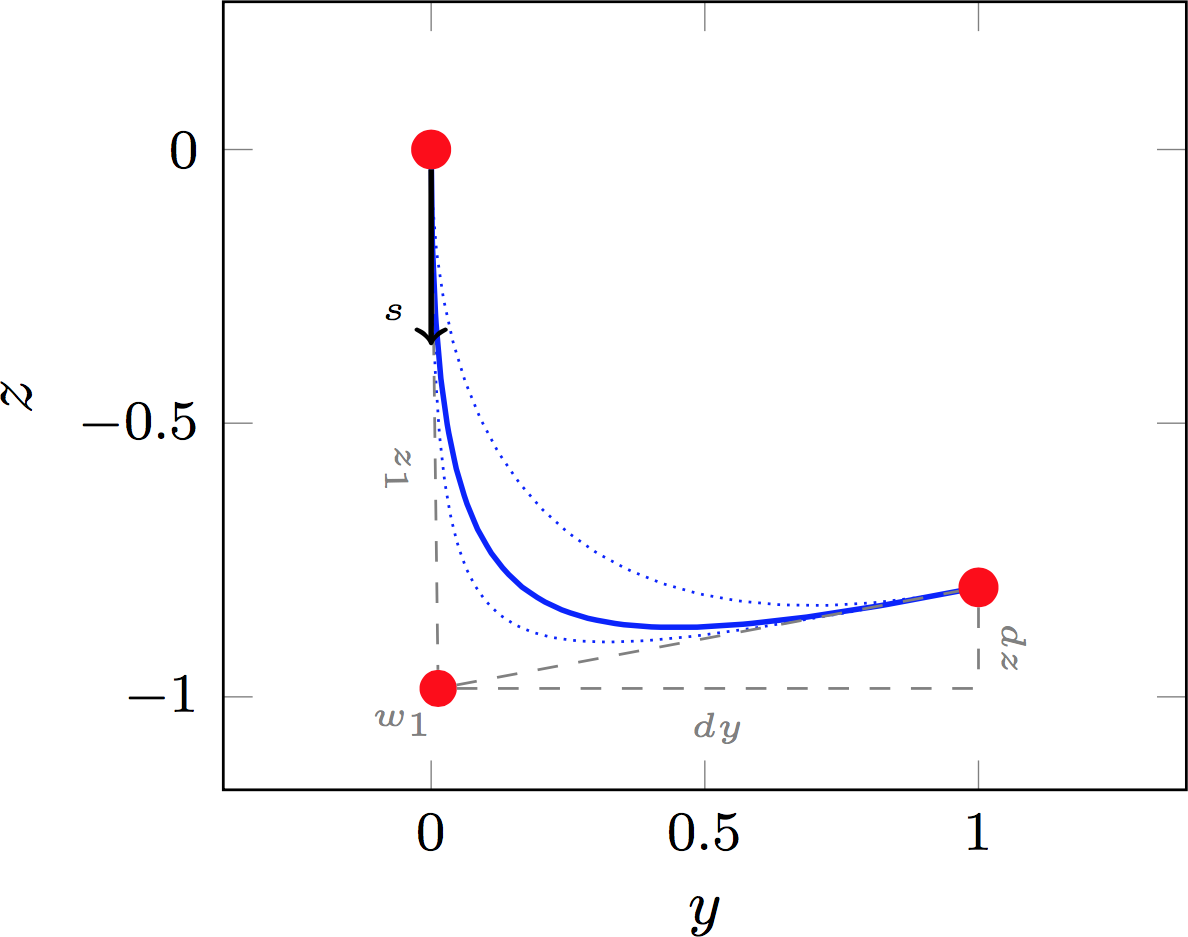 – S. Alimohammadi, P. Beyhaghi, G. Meneghello, and T. Bewley (2017) Delaunay-based optimization in CFD leveraging multivariate adaptive polyharmonic splines (MAPS). In 58th AIAA/ASCE/AHS/ASC Structures, Structural Dynamics, and Materials Conference, Grapevine, Texas (9 - 13 January 2017). doi: 10.2514/6.2017-0129
– S. Alimohammadi, P. Beyhaghi, G. Meneghello, and T. Bewley (2017) Delaunay-based optimization in CFD leveraging multivariate adaptive polyharmonic splines (MAPS). In 58th AIAA/ASCE/AHS/ASC Structures, Structural Dynamics, and Materials Conference, Grapevine, Texas (9 - 13 January 2017). doi: 10.2514/6.2017-0129 Delaunay-based derivative-free optimization leveraging global surrogates (Δ-DOGS) is a recently-developed optimization algorithm designed for nonsmooth functions in a handful of adjustable parameters. The first implementation of the original Δ-DOGS algorithm used polyharmonic splines to develop an inexpensive interpolating "surrogate" of the (expensive) function of interest. The behavior of this surrogate was found to be irregular in cases for which the function of interest turned out to be much more strongly dependent on some of the adjustable parameters than others. This irregularity of the surrogate led to the optimization algorithm requiring many more function evaluations than might have otherwise been necessary. In the present work, a modified interpolation strategy, dubbed multivariate adaptive polyharmonic splines (MAPS), is proposed to mitigate this irregular behavior, thereby accelerating the convergence of Δ-DOGS. The MAPS approach modifies the natural polyharmonic spline (NPS) approach by rescaling the parameters according to their significance in the optimization problem based on the data available at each iteration. This regularization of the NPS approach ultimately reduces the number of function evaluations required by Δ-DOGS to achieve a specified level of convergence in optimization problems characterized by parameters of varying degrees of significance. The importance of this rescaling of the parameters during the interpolation step is problem specific. To quantify its beneficial impact on a practical problem, we compare Δ-DOGS with MAPS to Δ-DOGS with NPS on an application related to hydrofoil shape optimization in seven parameters; results indicate a notable acceleration of convergence leveraging the MAPS approach.
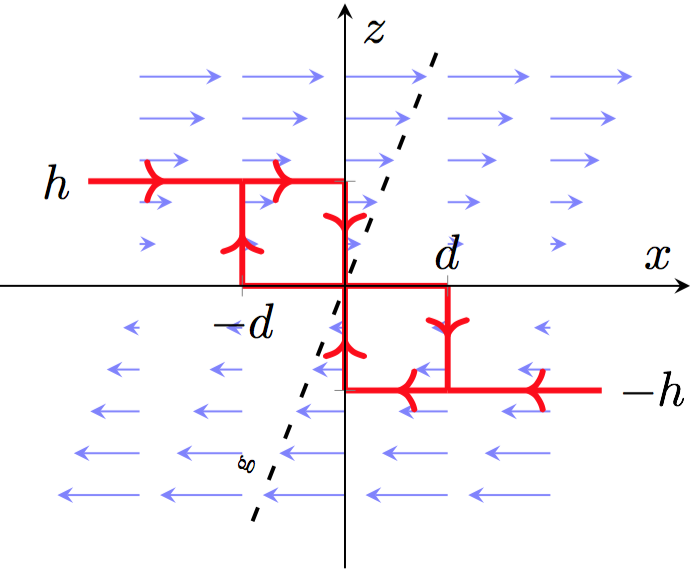 – G. Meneghello, P. Luchini and T. Bewley (2016) On the control of buoyancy-driven devices in stratified, uncertain flowfields. in Proceedings of the VIIIth International Symposium on Stratified Flows, San Diego, California. Permalink
– G. Meneghello, P. Luchini and T. Bewley (2016) On the control of buoyancy-driven devices in stratified, uncertain flowfields. in Proceedings of the VIIIth International Symposium on Stratified Flows, San Diego, California. PermalinkThe feasibility of a buoyancy-based control approach for regulating the horizontal position of atmospheric balloons in stratified and turbulent environmental flows is investigated. Two different control rules are considered, and numerical investigations are performed for a challenging case related to tropical cyclones. The low energy requirement of the buoyancy-based control approach allows continuous, in-situ observations that extend over much longer periods, and at a significantly reduced cost, than what is achievable with current observation platforms, while maintaining a high degree of maneuverability.
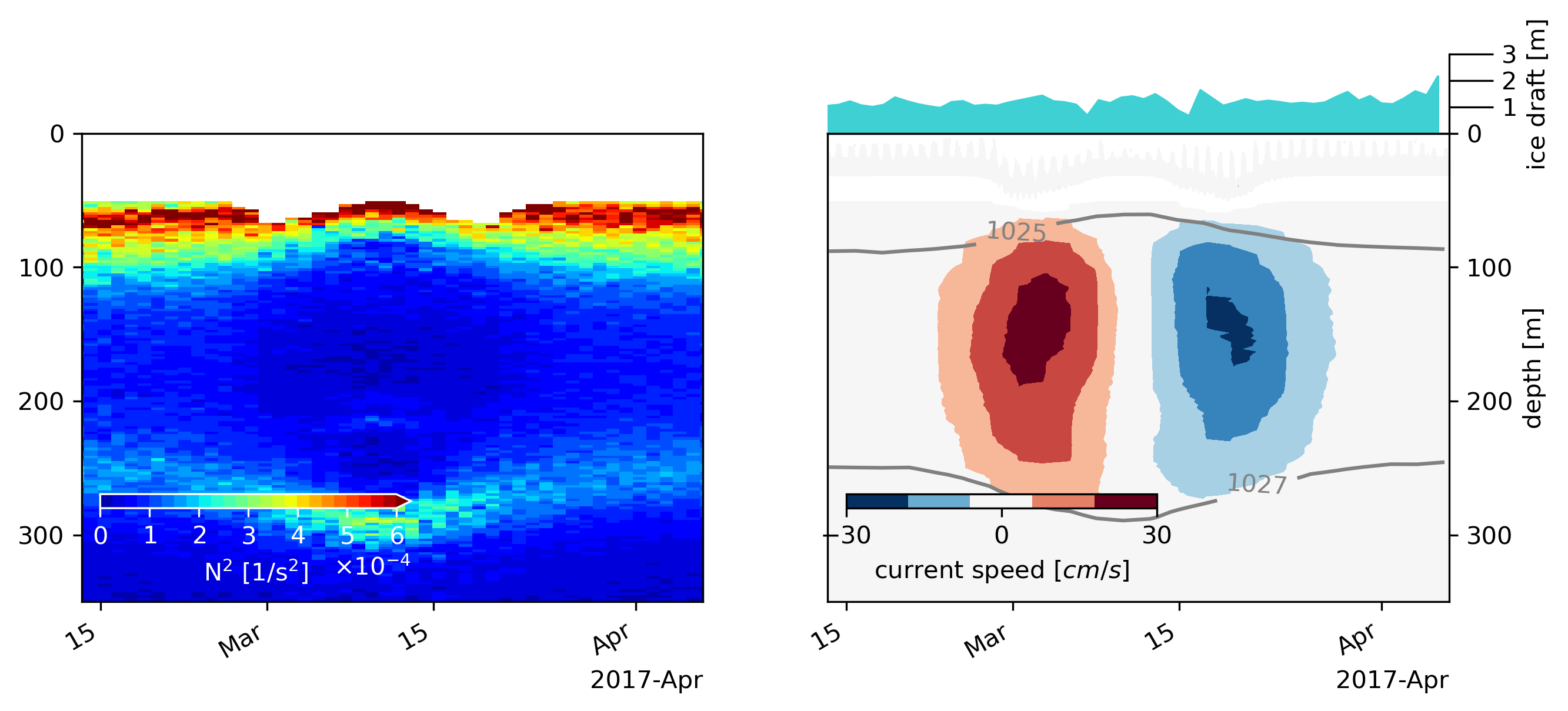 – G. Meneghello, J. Marshall, C. Lique, P-E Isachsen, E. Doddridge, J.M. Campin, H. Regan, C. Talandier Genesis and decay of baroclinic eddies in the seasonally ice-covered Arctic Ocean
Presented at the 2023 Polar Marine Science Gordon Research Conference, Ventura, California, 5-10 March (2023)
– G. Meneghello, J. Marshall, C. Lique, P-E Isachsen, E. Doddridge, J.M. Campin, H. Regan, C. Talandier Genesis and decay of baroclinic eddies in the seasonally ice-covered Arctic Ocean
Presented at the 2023 Polar Marine Science Gordon Research Conference, Ventura, California, 5-10 March (2023) Baroclinic eddies play an important role in the equilibrium of the large-scale circulation, ventilation of tracers, upper-ocean biology, and pollutant dispersion in the ocean. In the Arctic, observational evidence shows a curious, and hitherto unexplained, vertical distribution of eddy kinetic energy. A marked seasonal cycle is found close to the surface: strong eddy activity during summer, observed from both satellites and moorings, is followed by very quiet winters. In contrast, subsurface eddies persist all year long within the deeper halocline. Informed by baroclinic instability analysis, and a high resolution pan-Arctic ocean model, we explore the origin and evolution of baroclinic eddies in the seasonally ice-covered Arctic Ocean. Mixed-layer baroclinic eddies are generated in the summer and decay in the winter as the growth of ice enhances decay of eddies. Meanwhile baroclinic eddies which obtain their energy from the halocline below persist year round and are less susceptible to the seasonal cycle.
 – G. Meneghello, J. Marshall, C. Lique, P-E Isachsen, E. Doddridge, J.M. Campin, H. Regan, C. Talandier Genesis and decay of baroclinic eddies in the seasonally ice-covered Arctic Ocean
Presented at 2020 Ocean Sciences, San Diego, California, 16-21 Feb (2020)
– G. Meneghello, J. Marshall, C. Lique, P-E Isachsen, E. Doddridge, J.M. Campin, H. Regan, C. Talandier Genesis and decay of baroclinic eddies in the seasonally ice-covered Arctic Ocean
Presented at 2020 Ocean Sciences, San Diego, California, 16-21 Feb (2020) Baroclinic eddies play an important role in the equilibrium of the large-scale circulation, ventilation of tracers, upper-ocean biology, and pollutant dispersion in the ocean. In the Arctic, observational evidence shows a curious, and hitherto unexplained, vertical distribution of eddy kinetic energy. A marked seasonal cycle is found close to the surface: strong eddy activity during summer, observed from both satellites and moorings, is followed by very quiet winters. In contrast, subsurface eddies persist all year long within the deeper halocline. Informed by baroclinic instability analysis, and a high resolution pan-Arctic ocean model, we explore the origin and evolution of baroclinic eddies in the seasonally ice-covered Arctic Ocean. Mixed-layer baroclinic eddies are generated in the summer and decay in the winter as the growth of ice enhances decay of eddies. Meanwhile baroclinic eddies which obtain their energy from the halocline below persist year round and are less susceptible to the seasonal cycle.
 – G. Meneghello, E. Doddridge, J. Marshall, J. Scott. and J.M. Campin Exploring the role of the "Ice-Ocean governor" and mesoscale eddies in the equilibration of the Beaufort Gyre: lessons from observations
Presented at 2020 Ocean Sciences, San Diego, California, 16-21 Feb (2020)
– G. Meneghello, E. Doddridge, J. Marshall, J. Scott. and J.M. Campin Exploring the role of the "Ice-Ocean governor" and mesoscale eddies in the equilibration of the Beaufort Gyre: lessons from observations
Presented at 2020 Ocean Sciences, San Diego, California, 16-21 Feb (2020) Observations of Ekman pumping, sea surface height anomaly, and isohaline depth anomaly over the Beaufort Gyre are used to explore the relative importance and role of (i) feedbacks between ice and ocean currents, dubbed the ``Ice-Ocean governor'' and (ii) mesoscale eddy processes in the equilibration of the Beaufort Gyre. A two-layer model of the gyre is fit to observations and used to explore the mechanisms governing the gyre evolution from the monthly to the decennial time scale. The Ice-Ocean governor dominates the response on inter-annual timescales, with eddy processes becoming evident on the longest, decadal timescales.
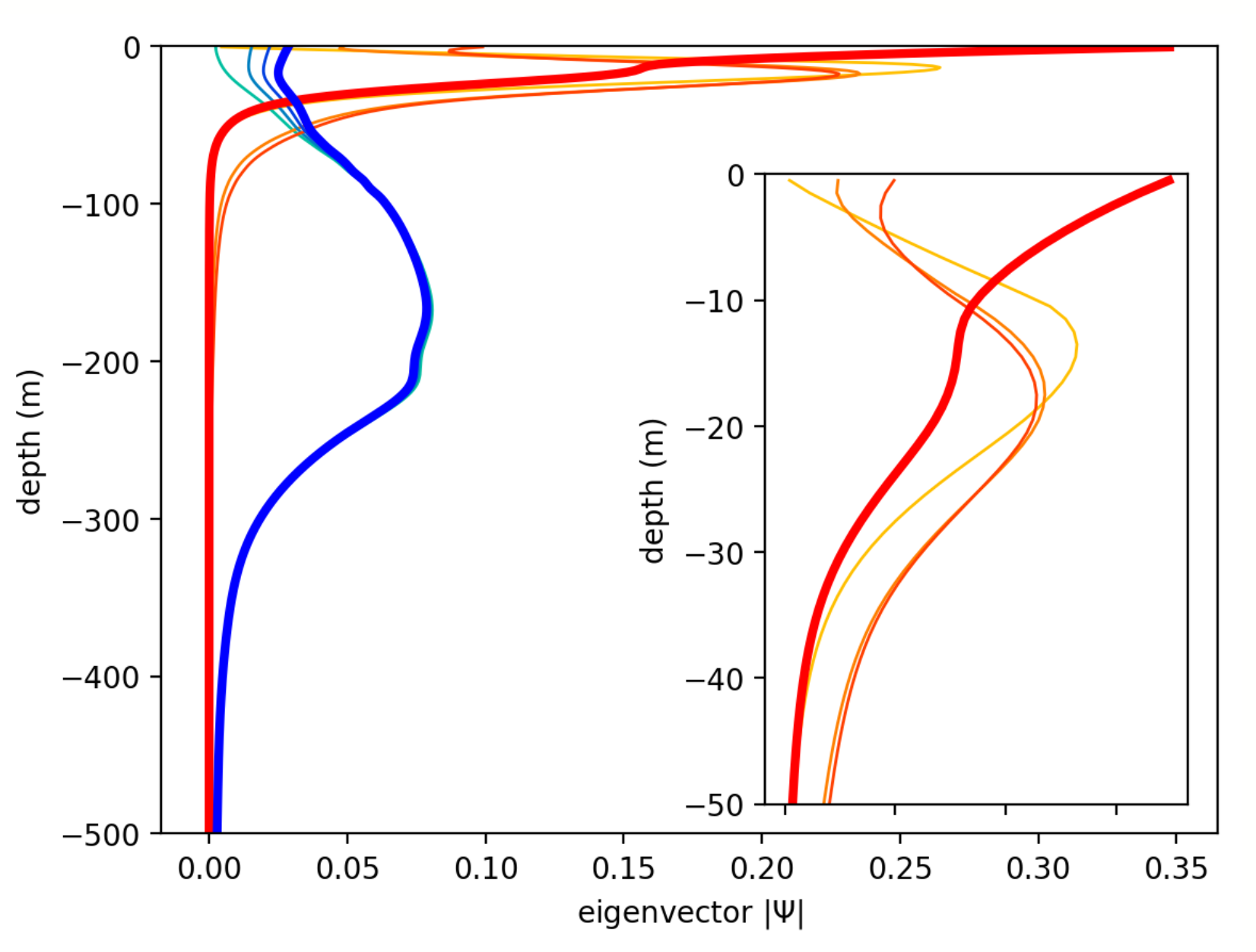 – G. Meneghello, E. Doddridge, J. Marshall, J. Scott. and J.M. Campin Baroclinic instability and eddy fluxes in a seasonally ice-covered ocean
Presented at 2019 IUGG, Montreal, Canada, 8-18 Jul (2019)
– G. Meneghello, E. Doddridge, J. Marshall, J. Scott. and J.M. Campin Baroclinic instability and eddy fluxes in a seasonally ice-covered ocean
Presented at 2019 IUGG, Montreal, Canada, 8-18 Jul (2019) We address the origin and seasonal evolution of the eddy field in the Arctic. The origin of both mixed layer and halocline eddies is found in the development of baroclinic instability. The formation and evolution of mixed layer eddies is strongly modulated by the seasonal cycle in the ice cover.
 – G. Meneghello, J. Marshall, M.-L. Timmermans and J. Scott. Observations of seasonal upwelling and downwelling in the Beaufort Sea mediated by sea ice. Presented at 6th FAMOS workshop, WHOI, Woods Hole, MA, 24-27 Oct (2017)
– G. Meneghello, J. Marshall, M.-L. Timmermans and J. Scott. Observations of seasonal upwelling and downwelling in the Beaufort Sea mediated by sea ice. Presented at 6th FAMOS workshop, WHOI, Woods Hole, MA, 24-27 Oct (2017) We present observational estimates of Ekman pumping in the Beaufort Gyre region. Averaged over the Canada Basin, our results show a 2003-2012 average of 2.5m/y downward with strong seasonal and interannual variability superimposed: monthly and yearly means range from 30m/y downward to 10m/y upward. A clear seasonal cycle is evident with intense downwelling in autumn and upwelling during the winter months. Wintertime upwelling is associated with friction between the large scale Beaufort Gyre ocean circulation and the surface ice pack, and contrasts with previous estimates of year-long downwelling; as a consequence, the yearly cumulative Ekman pumping over the gyre is significantly reduced. The spatial distribution of Ekman pumping is modified as well, with the Beaufort Gyre region showing alternating, moderate upwelling and downwelling, while a more intense, year-long downwelling averaging 17.5m/y is identified in the northern Chukchi Sea region. Implications of our results for understanding Arctic Ocean dynamics and change are discussed.
 – G. Meneghello, J. Marshall, S.T. Cole and M.-L. Timmermans. Observational inferences of lateral eddy diffusivity in the halocline of the Beaufort Gyre. Presented at 6th FAMOS workshop, WHOI, Woods Hole, MA, 24-27 Oct (2017)
– G. Meneghello, J. Marshall, S.T. Cole and M.-L. Timmermans. Observational inferences of lateral eddy diffusivity in the halocline of the Beaufort Gyre. Presented at 6th FAMOS workshop, WHOI, Woods Hole, MA, 24-27 Oct (2017) Using Ekman pumping rates mediated by sea-ice in the Arctic Ocean's Beaufort Gyre (BG), the magnitude of lateral eddy diffusivities required to balance downward pumping is inferred. In this limit --- that of vanishing residual-mean circulation --- eddy-induced upwelling exactly balances downward pumping. The implied eddy diffusivity varies spatially with values of 50-400 m2/s, and decays with depth. Eddy diffusivity estimated using mixing length theory applied to BG mooring data exhibits a similar range of values from 100 m2/s to more than 600 m2/s, and also decays with depth. We conclude that eddy diffusivities in the BG are likely large enough to balance downward Ekman pumping, arresting the deepening of the gyre and suggesting that eddies play a zero-order role in buoyancy and freshwater budgets of the BG.
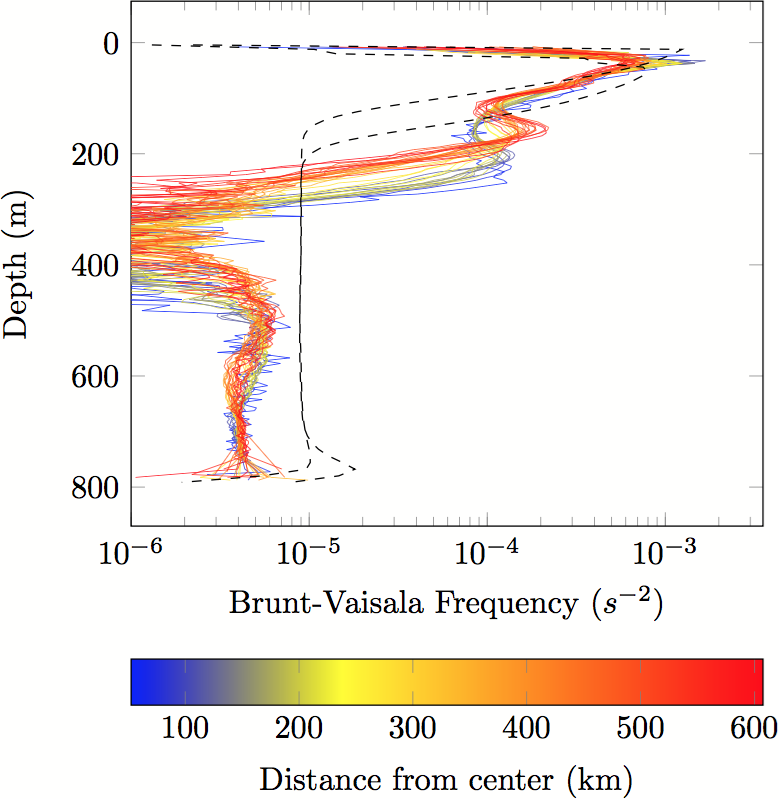 – G. Meneghello, J. Marshall and J-M. Campin. Equilibration of the Beaufort Gyre by baroclinic eddies.
Presented at 5th FAMOS workshop, WHOI, Woods Hole, MA, 2-4 Nov (2016)
– G. Meneghello, J. Marshall and J-M. Campin. Equilibration of the Beaufort Gyre by baroclinic eddies.
Presented at 5th FAMOS workshop, WHOI, Woods Hole, MA, 2-4 Nov (2016)The Arctic's fresh water increase of the past thirty years is in large part concentrated in the Beaufort Gyre (see, e.g. Haine 2015). In order to better understand the main mechanisms behind this change, we build on previous theoretical models by Marshall, Karsten (2002) and Manucharyan (2015) in which the effect of the wind pumping down freshwater in to the gyre is equilibrated by lateral 'bolus fluxes' by eddies. We identify key non-dimensionless parameters and review scaling laws governing the fresh water content of the gyre. Using data from previous idealized rotating fluid experiments and new numerical experiments, we show that a single dimensionless parameter is sufficient to characterize the buoyancy anomaly over a wide range of values. Additionally, comparison with results for the Antarctic Circumpolar Current suggests that the same scaling holds in both cases. Finally, theoretical and numerical predictions are compared with observations.
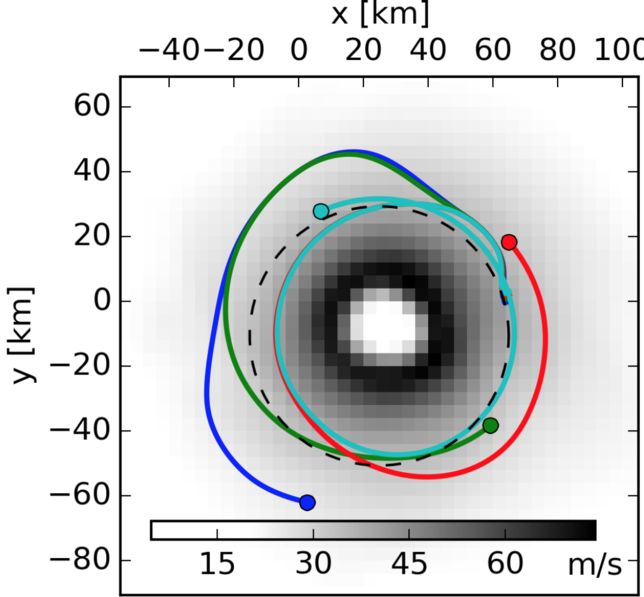 – G. Meneghello and T. Bewley. Atmospheric Balloons for Persistent In-Situ Measurements in Hurricanes.
Presented at AGU Fall meeting, San Francisco, CA (2015)
– G. Meneghello and T. Bewley. Atmospheric Balloons for Persistent In-Situ Measurements in Hurricanes.
Presented at AGU Fall meeting, San Francisco, CA (2015)Real-time measurements within hurricanes are essential to improve forecasts, protect property and save lives. Current methods for obtaining in-situ data, including radar and satellite imagery as well as drop-sondes deployed from repeated aircraft flights above or even within the hurricane itself, are costly, dangerous and limited in duration or resolution. We demonstrate how a swarm of inexpensive, buoyancy-controlled, sensor-laden balloons can be deployed from altitude or from sea-level within a hurricane flow field, and coordinated autonomously in an energetically-efficient fashion to persistently and continuously monitor relevant properties (pressure, humidity, temperature, windspeed) of a hurricane for days at a time. Rather than fighting the gale-force winds in the storm, the strong, predictable stratification of these winds is leveraged to disperse the balloons into a favorable, time-evolving distribution and to follow the hurricane track as it moves. Certain target orbits of interest in the hurricane can be continuously sampled by some balloons, while other balloons make continuous sweeps between the eye and the spiral rain bands. We expect the acquired data to complement current measurement methods and to be instrumental in improving the numerical models' forecast skills.
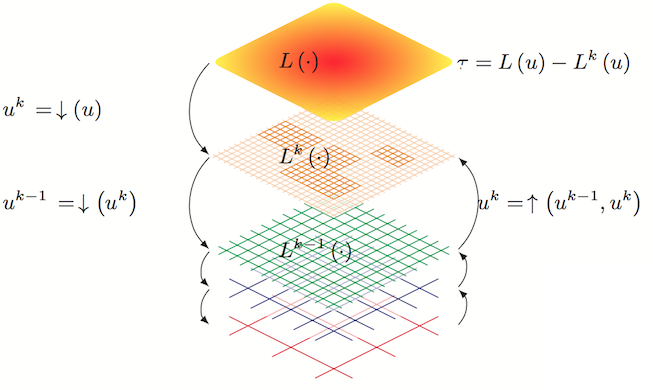 – G. Meneghello, P.J. Schmid and P. Huerre. Attachment line swept wing instability: a validation of local analysis.
Presented at the 2014 IPAM workshop, UCLA, Los Angeles, CA (2014)
– G. Meneghello, P.J. Schmid and P. Huerre. Attachment line swept wing instability: a validation of local analysis.
Presented at the 2014 IPAM workshop, UCLA, Los Angeles, CA (2014)We perform a global receptivity and sensitivity analysis of a swept-wing, incompressible boundary layer in a domain covering the attachment line as well as an extended region downstream of it. Despite performing our analysis in a stable flow regime — all our eigenvectors are decaying — we provide qualitative connections with previous local and global results in unstable regimes: the identification of the most receptive and sensitive regions within our domain provides an explanation for the validity of the local analysis results. The tools used are the one of modal analysis — eigenvectors and eigenvalues decomposition — and optimization theory. Receptivity and sensitivity form the foundation for the passive and active manipulation of the flow by applying control-theoretic means.
– Laboratoire de Météorologie Dynamique, ENS Paris (November 2022)
– GFD Program, Woods Hole Institution of Oceanography (July 2022)
– Dept. of Earth, Ocean & Atmospheric Science, Florida State University (April 2022)
– Laboratoire d'oceanographie physique et spatiale, IFREMER (March 2022)
– Dept. of Environmental Science and Engineering, Caltech (May 2020)
– NOAA's Physical Science Laboratory (June 2022)
– NOAA’s Hurricane Research Division, NEOTAC seminar series (May 2022)
– Dept. of Geosciences, Princeton University (November 2019)
– Dept. of Atmospheric and Oceanic Sciences, McGill University (July 2019)
– Dept. of Mathematics, New York University (April 2019)
– Civil and Environmental Engineering, Imperial College London (April 2019)
– Dept. of Geology & Geophysics, Yale University (February 2019)
– Dept. of EAPS, MIT (October 2018)
– Woods Hole Oceanographic Institution (October 2018)
– Dept. of Earth Sciences, University of Oxford (June 2018)
– Laboratoire d'oceanographie physique et spatiale, IFREMER Brest (June 2018)
– Laboratoire de Météorologie Dynamique, ENS Paris (June 2018)
– IPAM, UC Los Angeles (November 2014) (recording)
– Politecnico di Milano (March 2013)
– Universita di Salerno (March 2013)
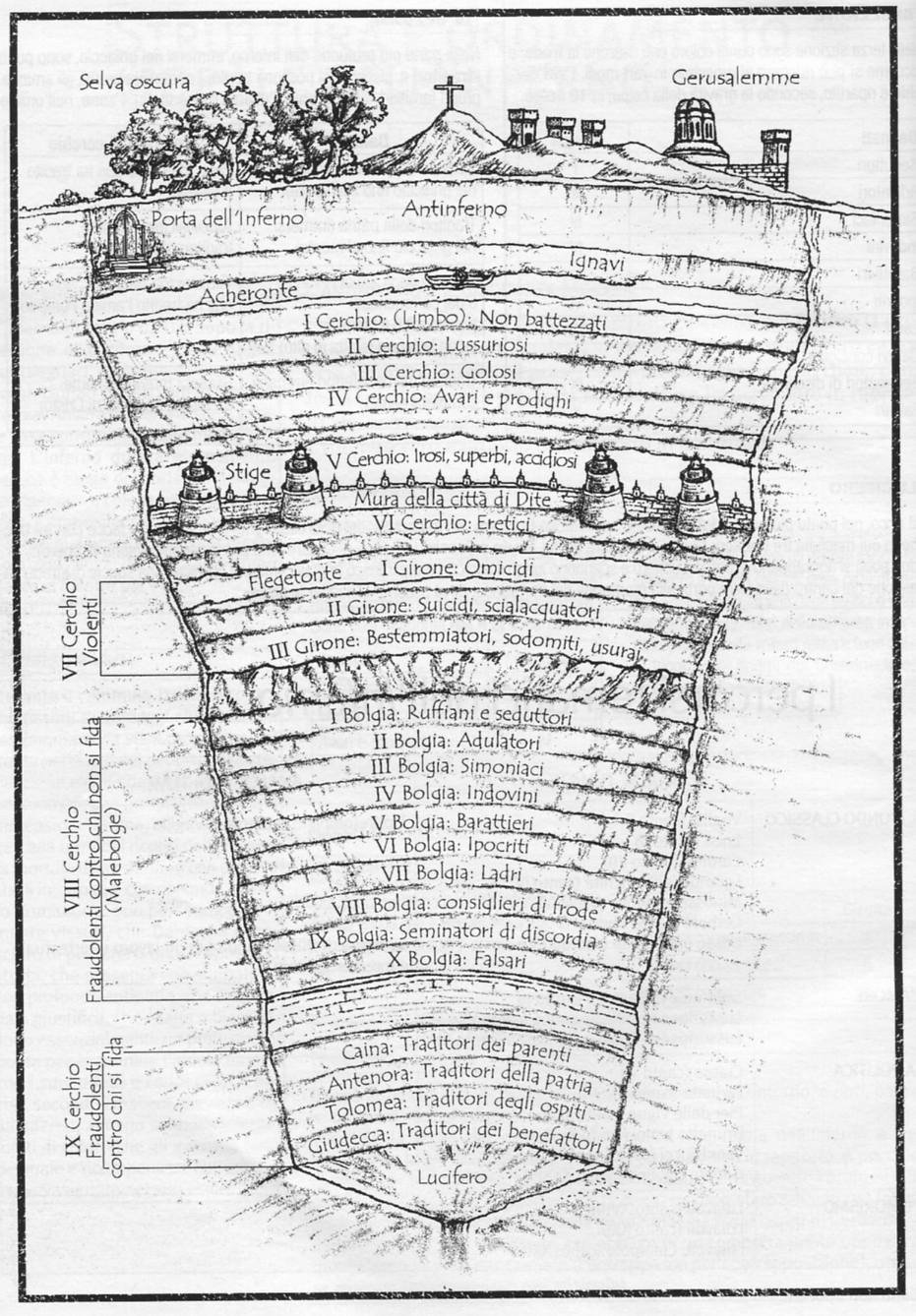 – G. Meneghello. Stability and receptivity of the swept-wing attachment-line boundary layer: a multigrid numerical approach.
Ecole Polytechnique X, Paris, France (2013)
– G. Meneghello. Stability and receptivity of the swept-wing attachment-line boundary layer: a multigrid numerical approach.
Ecole Polytechnique X, Paris, France (2013)The goal of this study is the analysis of the stability and receptivity properties of the three-dimensional flow past the leading edge of a swept wing. The project is divided into two parts: (i) the computation of the steady base flow as a solution of the steady-state Navier-Stokes equations and (ii) the study of the direct and adjoint eigenvalue problems obtained by linearizing the time-dependent Navier-Stokes equation around the base flow. In order to address the first part, a DNS code has been developed based on a multigrid framework. The solution of the non-linear steady-state Navier-Stokes equation at various Reynolds numbers is obtained by continuation at a computational cost of nearly O(n), where n is the number of degrees of freedom (dof) of the problem. The study of the stability and receptivity properties is performed by numerically solving the eigenvalue/eigenvector problem. A Krylov-Schur algorithm, coupled with a shift-invert spectral transformation, is used to extract part of the spectrum. Two branches may be identified and one of these is associated with eigenvectors displaying a connection between attachment line and cross-flow modes. The wave-maker region for these eigenvectors is shown to be located close to the attachment line by computing the corresponding solution to the adjoint eigenvalue problem. The numerical global results are compared qualitatively with existing experimental observations and local stability analysis.


